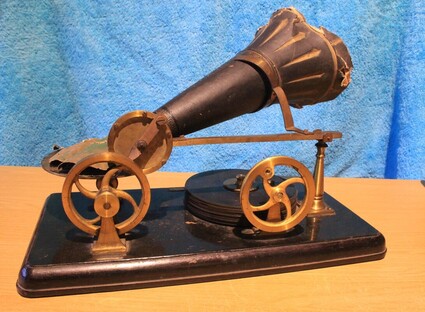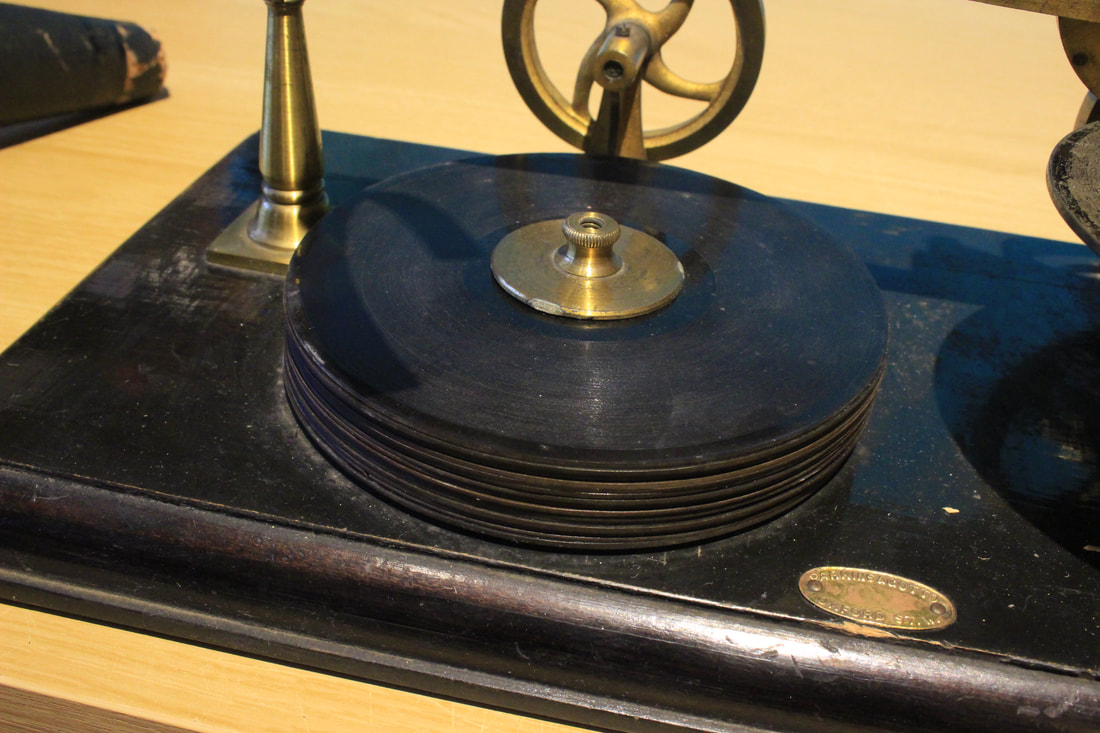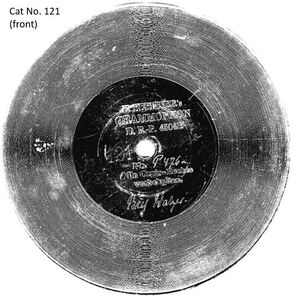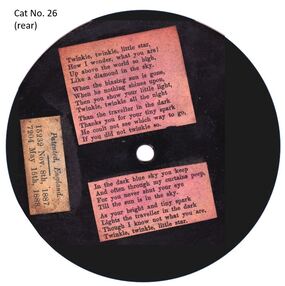BERLINER 5" DISCS
The concept of sound recording on discs was patented in 1887 in the USA by Emile Berliner, a young German immigrant engineer. His brother had a factory back in Hanover, which made technical equipment (mostly electrical and to do with telephones). It thus made sense to develop the idea, and do early production work and marketing there. Hence the manufacture of gramophones started in Germany.
The Kämmer Reinhardt & Co. Gramophone pictured (circa 1889–1892) is generally agreed to be the first disc record machine to be marketed in the UK. It is often regarded as a children’s toy, although the repertoire on its records indicates that this was not the intention. A less expensive children’s model was on sale in 1893. The discs were 12.5 cm (just under 5 inches) in diameter, and had a spiral groove containing laterally-impressed sound waves. The K R & Co. machines were sold in Britain from January 1891 by Parkins & Gotto of Oxford Street, London W; and also by the Central Co-operative Stores in High Holborn.
Toy it may have been; but since the ‘Gramophone outfit’ was expensive at £1 including twelve discs, it was essentially a toy for the children of the upper classes. £1 was more than a week’s wages for a factory worker at the time. Nevertheless, quite a few of these machines were sold, although they are extremely rare today.
There is a consensus that the discs should be played at 100-150 rpm. The problem is that there are very few musical instruments to be heard, so working out the correct playing speed (and thus pitch) is difficult. The discs are mostly of unaccompanied speech and song - and the latter don’t have to be in any specific musical key. All of the discs have thus been transferred at “best guess” speeds.
The fourteen discs featured below, and the K&R machine pictured, only recently came to light (in autumn 2019) in Shropshire. Huge thanks are due to their owner for making them available; and to Norman Field for the transfers, photos, accompanying notes and background details.
For more information about Berliner 5" discs please see the Archephone website.
The Kämmer Reinhardt & Co. Gramophone pictured (circa 1889–1892) is generally agreed to be the first disc record machine to be marketed in the UK. It is often regarded as a children’s toy, although the repertoire on its records indicates that this was not the intention. A less expensive children’s model was on sale in 1893. The discs were 12.5 cm (just under 5 inches) in diameter, and had a spiral groove containing laterally-impressed sound waves. The K R & Co. machines were sold in Britain from January 1891 by Parkins & Gotto of Oxford Street, London W; and also by the Central Co-operative Stores in High Holborn.
Toy it may have been; but since the ‘Gramophone outfit’ was expensive at £1 including twelve discs, it was essentially a toy for the children of the upper classes. £1 was more than a week’s wages for a factory worker at the time. Nevertheless, quite a few of these machines were sold, although they are extremely rare today.
There is a consensus that the discs should be played at 100-150 rpm. The problem is that there are very few musical instruments to be heard, so working out the correct playing speed (and thus pitch) is difficult. The discs are mostly of unaccompanied speech and song - and the latter don’t have to be in any specific musical key. All of the discs have thus been transferred at “best guess” speeds.
The fourteen discs featured below, and the K&R machine pictured, only recently came to light (in autumn 2019) in Shropshire. Huge thanks are due to their owner for making them available; and to Norman Field for the transfers, photos, accompanying notes and background details.
For more information about Berliner 5" discs please see the Archephone website.
Cat No. 26: Twinkle Twinkle Little Star (spoken)
Always reputed to have been spoken by Emile Berliner, the inventor of the gramophone. Sound quite good. He is usually said to have a pronounced German accent, but it’s not obvious. (Probably a myth; after all, he had lived in the USA for 20+ years)
Always reputed to have been spoken by Emile Berliner, the inventor of the gramophone. Sound quite good. He is usually said to have a pronounced German accent, but it’s not obvious. (Probably a myth; after all, he had lived in the USA for 20+ years)
Cat No. 28: Morning Hymn (Awake my Soul) (spoken)
This disc plays well, but the speech is rather fuzzy due to the poor upper frequency response, which only goes to just over 1000 Hz. The mechanical recording system was always limited to about 200 - 2500 Hz on discs. (Today this is called ‘Telephone Quality’; it enables accurate transmission of information by speech, without excessive ‘High Quality’ that adds nothing to the intelligibility (and indeed may sometimes detract from it)).
This disc plays well, but the speech is rather fuzzy due to the poor upper frequency response, which only goes to just over 1000 Hz. The mechanical recording system was always limited to about 200 - 2500 Hz on discs. (Today this is called ‘Telephone Quality’; it enables accurate transmission of information by speech, without excessive ‘High Quality’ that adds nothing to the intelligibility (and indeed may sometimes detract from it)).
Cat No. 29: Jack and Jill; Tom, Tom; etc (spoken)
Archeophone have this disc on their site, but there is no sample of it. It might well be spoken by a girl or young woman, so the playing speed was chosen accordingly.
Archeophone have this disc on their site, but there is no sample of it. It might well be spoken by a girl or young woman, so the playing speed was chosen accordingly.
Cat No. 30: Mary Had a Little Lamb; and Humpty Dumpty (spoken)
This plays fairly well; the speaker has a distinct English dialect: listen to how he says ‘agayne’ at the end of Humpty Dumpty. Archeophone don’t have this disc on their site, only the title.
This plays fairly well; the speaker has a distinct English dialect: listen to how he says ‘agayne’ at the end of Humpty Dumpty. Archeophone don’t have this disc on their site, only the title.
Cat No. 35: Who Killed Cock Robin (spoken)
Alas, not in very good condition.
Alas, not in very good condition.
Cat No. 36: Sing a Song of Six Pence (sic) (spoken)
This transfer may be a bit slow… the general quality is poor, a couple of ‘skip grooves’ have been repaired.
This transfer may be a bit slow… the general quality is poor, a couple of ‘skip grooves’ have been repaired.
Cat No. 37: Old Mother Hubbard (spoken)
A good ‘forward’ recording, but alas the disc is quite badly worn.
A good ‘forward’ recording, but alas the disc is quite badly worn.
Cat No. 41: For You, For You My Darling (sung, in Bb)
This singer seems to have a fairly high voice; here he is in B flat, following the example of Archeophone.
This singer seems to have a fairly high voice; here he is in B flat, following the example of Archeophone.
Cat No. 42: Auld Lang Syne (sung)
At last a good clear recording. Though unaccompanied, the song is published in G, which seems to work quite well. The singer is rather ‘Dickensian’? Archeophone have this title, but have seen no disc.
At last a good clear recording. Though unaccompanied, the song is published in G, which seems to work quite well. The singer is rather ‘Dickensian’? Archeophone have this title, but have seen no disc.
Cat No. 45: Voix Animaux (Farmyard imitations)
"Voices of Animals". Transferred at the most plausible speed.
"Voices of Animals". Transferred at the most plausible speed.
Cat No. 48: Rule Britannia (sung)
This is usually in the key of G, so that has been used. The singer is enthusiastic if slightly wobbly. But it comes over well in spite of the wear.
This is usually in the key of G, so that has been used. The singer is enthusiastic if slightly wobbly. But it comes over well in spite of the wear.
Cat No. 88: Heil Dir; and God Save the Queen (Brass Quintet)
This recording was listed in the German catalogue, and so was intended for sale in Germany. Thus the first title shown on the label (on the rear side) is Heil Dir, which was then the German Empire Anthem. The second title given is God Save the Queen - both pieces share the same tune – so the record was also sold in the UK, where of course it pertained to Queen Victoria.
The music was written in the key of F, so that has been used for the transfer. Of course, there were all sorts of variations in ‘standard pitch’ within Europe, but usually not large enough to cause serious problems.
This recording was listed in the German catalogue, and so was intended for sale in Germany. Thus the first title shown on the label (on the rear side) is Heil Dir, which was then the German Empire Anthem. The second title given is God Save the Queen - both pieces share the same tune – so the record was also sold in the UK, where of course it pertained to Queen Victoria.
The music was written in the key of F, so that has been used for the transfer. Of course, there were all sorts of variations in ‘standard pitch’ within Europe, but usually not large enough to cause serious problems.
Cat No. 121: Bierwalzer (Piano, in Eb).
"Beer(garden) Waltz". An astonishingly good recording – the piano was notoriously difficult to record under the old mechanical system. How they made it this good in 1890, I have no idea!
"Beer(garden) Waltz". An astonishingly good recording – the piano was notoriously difficult to record under the old mechanical system. How they made it this good in 1890, I have no idea!
Cat No. 164: Le Père La Victoire (sung, in C).
"The Father(land), The Victory". Alas, the record is fairly badly worn; C is the published key, but it might have been sung in France in almost any key in 1890. But it sounds reasonable at this speed. Archeophone lists the title, but have not seen this disc.
"The Father(land), The Victory". Alas, the record is fairly badly worn; C is the published key, but it might have been sung in France in almost any key in 1890. But it sounds reasonable at this speed. Archeophone lists the title, but have not seen this disc.




